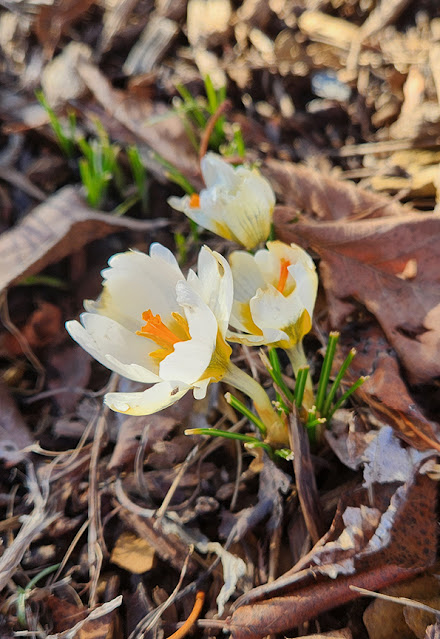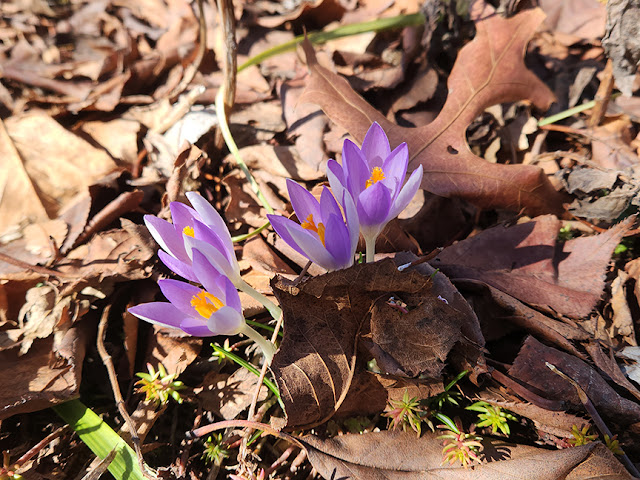 |
| Magnolia 'Butterflies' |
It's been one of the driest winters in this corner of Virginia, and March was little better until the very last day, when a series of thunderstorms hit our area, dropping nearly an inch of rain overnight. What a delightful surprise just before April Fool's!
With the stealth rain, my garden has come alive with the annual miracle of spring! My yellow-flowered Magnolia 'Butterflies' didn't get badly frosted this year--ironic, considering there were fewer buds than any year before, due to last summer's drought. But still, it's the first spring since it was planted eight years ago that I've had the opportunity to enjoy its beautiful blossoms.
 |
| The front yard with Thalia narcissus and Magnolia 'Butterflies' |
As the early 'February Gold' daffodils fade, the front yard comes alive with the blooms of Thalias, Tazettas, and Poet's Narcissus, forming thickets of white with touches of yellow. The creeping Phlox under the cherry tree is starting to revive too.
 |
| My front yard on April Fool's Day. |
 |
| Tazetta, Thalia, and Poet's Narcissus. |
The Yoshino cheries in our neighborhood are gorgeous at the moment, though with the wind today the blossoms are bound to be short-lived. It will take a couple more weeks for the Kwanzan cherry in my yard to open, although the buds are swelling and starting to show some color.
On the east side of the house several patches of blue Siberian Squill are all in bloom, and my Hellebores finally open. The Pieris beyond is also sporting its delicate blossoms.
 |
| Siberian Squill (Scilla siberica) |
 |
| Hellebore 'True Love' |
 | ||||||
| Hellebore 'Flower Girl' |
 |
| Pieris japonica |
Last fall I planted a native Jacob's Ladder plant in the woodland garden on the east of the house, and it's loaded with flower buds, the first of which are starting to open. I'd had a couple of beautiful hybrids with variegated foliage of this plant a few years ago, but those were eaten by something (deer? voles?) and died out. I think the species may prove a bit more resistant to the onslaught of the critters, but I'm keeping it under a cloche in hopes it will spread.
 |
| Jacob's Ladder (Polemonium reptans) |
My Allegheny Serviceberry tree (Amelanchier laevis) is also blooming, though my little tree hasn't made a whole lot of progress in the past years. I hope this year it will finally grow tall enough to be out of the deers' reach.
 |
| Allegheny Serviceberry tree (Amelanchier laevis) |
The back bed has exploded into bloom with assorted daffodils: 'Pink Charm' at one end, with 'Mount Hood' and a mixture of other varieties. The redbud tree is just starting to show some color, while the Seven Son Flower Tree leafs out. The Forsythia beyond is holding its blossoms well despite the wind.
 |
| The back bed with Forsythia beyond. |
 |
| The back bed. |
 |
| 'Pink Charm' daffodils |
 |
| 'Pink Charm' |
Yellow 'Prince Alfred' substitutes are blooming in another bed, and the Mount Hood daffodils I divided a couple of years ago are everywhere too.
 |
| 'Mount Hood' daffodils |
 |
| 'Prince Alfred' look-alike daffodils. |
There's a nice patch of blue Muscari blooming in the front bed next to the driveway, along with charming little Anemones in a blue-and white combination, but today it's too chilly and windy for the Anemones to open (these photos are from a few days ago).
 |
| Blue Grape Hyacinths (Muscari armeniacum) and Anemones (Anemone blanda). |
 |
| Grecian windflowers (Anemone blanda) |
As Mother Nature revives, the annual miracle of Spring is on full display...I can't wait to see what will come into bloom in time for April's Bloom Day!




































